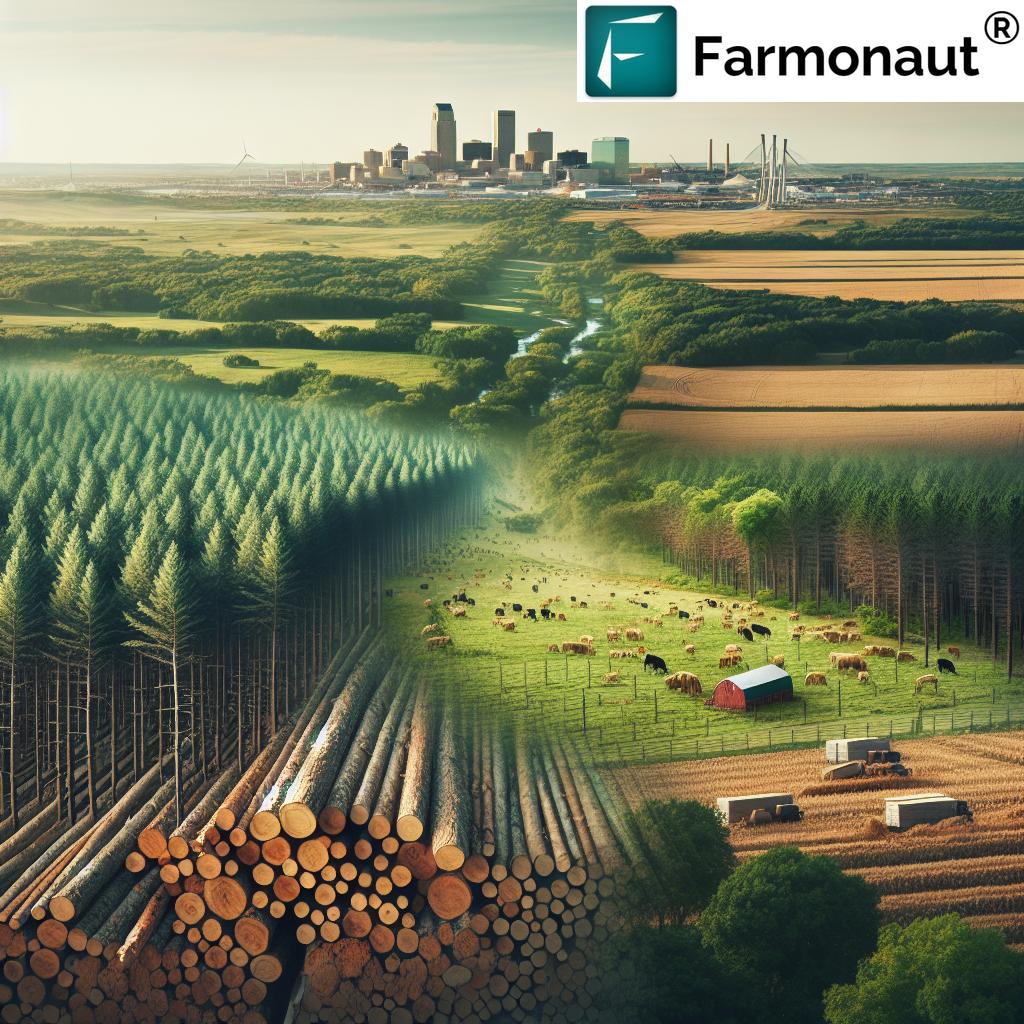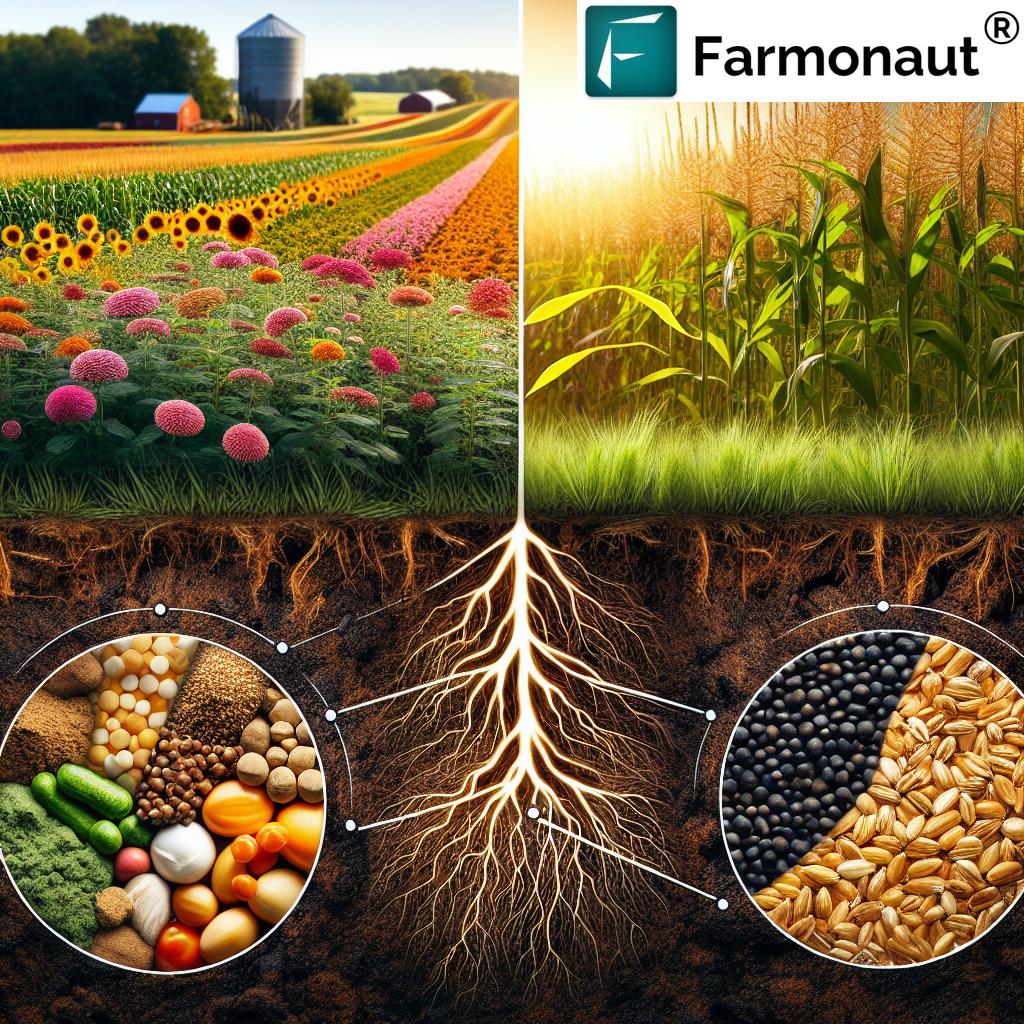Table of Contents
- Fast Facts: Nebraska’s Agri & Forestry Economy
- Introduction
- Agriculture: The Backbone of Nebraska’s Economy
- Top 7 Agri & Forestry Trends Shaping Nebraska’s Economy
- Nebraska Forestry: Enhancing Natural Resources
- Nebraska Agriculture & Forestry Economic Impact Table
- Agricultural & Forestry Employment Landscape in Nebraska
- Agricultural Education & Workforce Readiness
- Climate Change Impacts and Sustainability Efforts
- How Farmonaut Empowers Nebraska Agriculture
- Recent Developments in Nebraska Agriculture
- FAQs on Nebraska Agricultural Economy
- Farmonaut Subscription Plans
- Conclusion
“Nebraska agriculture supports over 1 in 4 jobs statewide, making it a cornerstone of the state’s employment sector.”
Nebraska Economy and Jobs: Top 7 Agri & Forestry Trends
Nebraska’s rich, fertile landscape is not just a symbol of the region’s natural beauty; it’s the foundation of our state’s economy, culture, and employment. As we explore how Nebraska agriculture and forestry drive economic development, we’ll discover the pivotal role these sectors play in fostering jobs, adapting to climate change, and generating new, diverse opportunities for Nebraskans in both urban and rural areas.
In this comprehensive article, we dive into the top seven agriculture and forestry trends that are shaping the economic landscape of Nebraska. We also highlight the essential contributions of agri-tech solutions, sustainable practices, industry innovations, and the steadfast commitment of our agricultural workforce.
Whether you are a farmer, agribusiness owner, policymaker, student, or simply passionate about Nebraska’s economic future, this article will provide actionable insights, compelling data, and forward-thinking analysis—especially in the context of rapid changes in environmental conditions and technology adoption.
Agriculture: The Backbone of Nebraska’s Economy
Nebraska agriculture is the backbone of the state’s economic landscape. Thanks to fertile soil and favorable climate conditions, Nebraska has consistently ranked among the top producers of critical agricultural commodities within the nation and across international markets. Our production of crops and livestock not only sustains local communities but also feeds and fuels the world.
Crop Production in Nebraska: Corn, Soybeans, and Beyond
Among the most renowned features of our agricultural output are the vast corn fields that contribute significantly to both the national and global markets. Corn is a primary ingredient in animal feed, ethanol production, and a vast range of food products. Soybeans, another staple crop, are essential for oil extraction and as a major protein source in animal feeds. Together, these crops exemplify the robust, adaptive potential of Nebraska’s agricultural sector.
- Nebraska’s corn production consistently ranks among the top states in the US, supporting animal agriculture, biofuel industries, and food processing sectors.
- Soybean output is steadily increasing, cementing Nebraska’s role as a major supplier of essential agricultural commodities.
- Crops such as wheat, grain sorghum, sugar beets, and specialty varieties further diversify the crop production in Nebraska.
Livestock Industry: A Major Driver for Employment and Output
The livestock sector is an integral component of our agricultural economy. Nebraska is renowned for its beef production, ranking among the nation’s top beef-producing states. Cattle and hog farming make up the bulk of our animal agriculture, supporting:
- Numerous meatpacking and processing facilities, particularly in urban areas like Omaha and in counties such as Douglas County, which boasts over 29,000 agriculture-related jobs.
- Highly skilled jobs in animal husbandry, food processing, and livestock management across the state.
- Ancillary industries including animal feed production, veterinary services, and supply chains for biological and mechanical inputs.
Farming, Ranching, and Rural-Urban Economic Synergy
While traditional farming and ranching remain the cornerstone of many rural communities, the influence of agriculture extends well beyond the farm gates and into Nebraska’s urban centers. Facilities in Omaha and Lincoln, for example, represent hubs for food processing, agricultural business, research, and education—all crucial to the overall agricultural employment in Nebraska.
Top 7 Agri & Forestry Trends Shaping Nebraska’s Economy
Staying ahead in the ever-changing economic and environmental landscape requires adaptation and innovation. Here, we explore the top 7 trends propelling Nebraska’s agricultural and forestry sectors:
- Precision Farming & Ag-Tech Adoption: Using real-time data, satellite imagery, and AI-driven insights, Nebraska farmers are optimizing yields and minimizing resource waste. These advancements lower operational costs and support sustainable farming practices in Nebraska.
- Bioenergy Expansion: The growth in ethanol and biodiesel production using Nebraska’s corn and soybeans strengthens our contribution to the clean energy market and sustains rural jobs.
- Export Growth & Global Market Reach: Nebraska’s ability to produce surplus crops and livestock supports robust agricultural exports, fueling both local job growth and global food security.
- Sustainable Forestry Practices: Efforts to expand and manage forest resources ensure long-term environmental and economic vitality.
- Specialty Crop Diversification: From organic produce to high-value seed crops, diversification reduces risk and unlocks new market opportunities.
- Water Conservation Initiatives: In a climate characterized by variable rainfall, innovative water management strategies help maintain Nebraska crop yields and protect natural resources.
- Agri-Environmental Compliance and Carbon Tracking: With regulatory attention increasing, carbon footprint monitoring and resource-tracking solutions are becoming integral to sustainable operations across the state.
“Forestry and agriculture contribute more than $25 billion annually to Nebraska’s economy, driving significant industry growth.”
Nebraska Forestry: Enhancing Natural Resources for Economic Growth
While Nebraska’s landscape is dominated by cropland, the role of forestry in Nebraska should not be underestimated. Through the stewardship of the Nebraska Forest Service, the state is enhancing both managed and wild forest resources.
- Managed forests contribute to timber production, supporting local economies and creating forestry jobs Nebraska-wide.
- Conservation programs, carbon sequestration initiatives, and recreational usage are expanding, with direct benefits to local communities and the environment.
- Adaptive management and planting efforts bolster climate change resilience while providing ecosystem services such as wildlife habitat and flood regulation.
According to the Nebraska Forest Service, our forestry industry’s economic contributions—including job creation, resource management, and ecosystem protection—are crucial to the wider state economy.
Nebraska Agriculture & Forestry Economic Impact Comparison Table
| Trend Name | Estimated Economic Contribution ($ millions) | Estimated Employment Impact (# of jobs) | Recent Change (% vs. previous year) | Climate Adaptation Relevance (Yes/No) |
|---|---|---|---|---|
| Precision Farming & Ag-Tech Adoption | $2,400 | 8,600 | +9% | Yes |
| Bioenergy Expansion | $1,200 | 3,500 | +3% | Yes |
| Ag-Tech Investments | $650 | 1,400 | +12% | Yes |
| Sustainable Forestry Practices | $480 | 1,050 | +4% | Yes |
| Export Growth | $6,800 | 15,200 | +6% | No |
| Specialty Crop Diversification | $305 | 780 | +14% | Yes |
| Water Conservation Initiatives | $160 | 570 | +7% | Yes |
Nebraska’s Agricultural & Forestry Employment Landscape
The agricultural and forestry sectors collectively provide one of the largest sources of employment throughout the state. Over 1 in 4 jobs in Nebraska are supported by agriculture, an astonishing figure that underlines the sector’s crucial economic role.
Urban-Rural Collaboration: Omaha, Douglas County & Beyond
Douglas County, including Omaha, leads in agriculture-related job creation—exceeding 29,000 positions. Employment opportunities span not just traditional farm labor but extend to agri-business, food processing, biotechnology, logistics, and environmental services.
- Rural areas: Focus on crop and livestock farming, machinery operation, land management, and animal care.
- Urban centers: Opportunities in research, food innovation, agri-tech, supply chain management, quality assurance, and agricultural finance.
Forestry Jobs Nebraska: Conservation, Management, and Recreation
The forestry industry in Nebraska is smaller compared to agriculture but steadily evolving, thanks to increased conservation awareness and sustainable forest management. Jobs are available in:
- Forestry management and planning (in both public and private sectors)
- Tree planting, timber harvesting, sawmills, and wood product manufacturing
- Ecosystem services, environmental education, and recreational management
Optimized fleet and resource management tools also create tech-driven roles for equipment operators, agronomists, and operations managers.
Diverse Career Pathways in Agriculture & Forestry
- Traditional crop and livestock farming
- Precision agriculture and digital farm management (see how Farmonaut supports large-scale management)
- Environmental science, conservation, and education
- Food technology, supply chain, and export logistics
- Resource management, agri-business analysis, and policy
Agricultural Education in Nebraska: Preparing the Future Workforce
Nebraska’s commitment to agricultural education and workforce development is vital for maintaining its leadership in the sector. Institutions like the Nebraska College of Technical Agriculture in Curtis and programs at the University of Nebraska-Lincoln provide specialized training.
- Technical and vocational training programs for emerging agri-tech careers
- Research and hands-on learning in fields such as crop production, animal science, sustainable forestry, and resource management
- Increased emphasis on environmental education, conservation, and adaptation to climate change impacts on Nebraska agriculture
These educational pipelines ensure a steady, skilled workforce ready to support advanced agricultural and forestry jobs across both rural and urban areas.
Addressing Labor Shortages & Climate Change Impacts on Nebraska Agriculture
The state’s agriculture and forestry sectors face critical challenges, particularly labor shortages and the effects of climate change. Recent events, such as labor disruptions at processing plants in Omaha, illustrate the fragility of a labor-dependent industry.
- Labor shortages disrupt production, highlight the need for automation, and emphasize the importance of workforce stability, especially during peak harvest or processing seasons.
- Climate change impacts crop yields in Nebraska through rising temperatures and variable precipitation, putting stress on soil health, water resources, and forest ecosystems.
Farmonaut’s Carbon Footprinting & Resource Management Solutions empower agribusinesses to monitor, report, and adapt their environmental impact in real time, supporting the move toward sustainable farming practices Nebraska.
- Advanced monitoring and blockchain-based traceability solutions provide transparency and strengthen supply chains, ensuring food safety and export reliability.
The Nebraska Forest Service drives forest conservation and climate adaptation, employing adaptive practices to sustain biodiversity, soil health, and water regulation.
How Farmonaut Technology Empowers Nebraska Agriculture and Forestry
As we seek innovative solutions to modern challenges, Farmonaut stands out as a pioneering agritech platform, especially relevant to Nebraska’s needs. By making precision agriculture affordable and accessible, Farmonaut helps Nebraskan farmers, agribusinesses, and public agencies stay at the forefront of the sector’s digital transformation.
- Satellite-based crop health monitoring, AI-driven advisory, and blockchain-enabled traceability help optimize Nebraska crop yields and resource efficiency.
- Resource management and carbon footprint tracking support compliance with environmental standards and promote sustainable development statewide.
- Accessible via Web, iOS, and Android apps—enabling Nebraska’s agricultural community to make data-driven decisions whenever and wherever needed.
These innovative tools are designed for individual farmers, cooperatives, agribusinesses, government agencies, and researchers—empowering all to boost productivity, enhance transparency, and achieve sustainable growth in Nebraska’s strong agricultural and forestry landscape.
- Robust crop loan and insurance verification solutions to reduce fraud and accelerate farm financing throughout our state.
- Powerful large-scale farm management tools for operations professionals and agribusiness managers.
Recent Developments & Industry News: Nebraska Agriculture in Transition
The landscape of Nebraska agriculture and jobs is anything but static. Recent news stories highlight the importance of adapting to changing social, economic, and regulatory environments:
-
US immigration raid of Omaha meat plant cuts staff, fuels food production worries:
Labor shortages reverberate across the industry, affecting food security and workplace stability. -
Nebraska GOP governor, lawmakers unveil tax-slashing plan:
Policy changes could further enhance the business climate for Nebraska agriculture and agri-business investment. -
Editorial Roundup: Nebraska:
Insightful analysis from local editorial boards on the outlook and resilience of the state’s agricultural sectors.
These recent developments underscore the dynamic, evolving nature of jobs and economic opportunities in Nebraska’s agricultural and forestry industries.
FAQs: Nebraska Agriculture & Forestry Economy
How significant is agriculture to Nebraska’s overall economy?
Agriculture is Nebraska’s single most important sector, supporting over one in four jobs statewide and providing more than $25 billion in annual economic contributions through crop production, livestock, and related agri-business activities.
What crops dominate Nebraska’s agricultural landscape?
Corn and soybeans are the chief crops, driving both Nebraska crop yields and exports. Wheat, grain sorghum, and specialty crops further contribute to crop production and market diversity.
How does forestry contribute to Nebraska’s economy and employment?
Nebraska forestry enhances natural resources, supports over a thousand jobs, and is increasingly vital for conservation, timber, and recreation.
What are the key challenges for Nebraska agriculture and forestry?
Key challenges include labor shortages, fluctuating markets, and the impacts of climate change on production and natural resources. Sustainable farming practices and technology adoption are vital for future resilience.
How is technology improving Nebraska’s agricultural sector?
Tech-enabled solutions such as Farmonaut’s satellite monitoring and data-driven advisory systems enable better decision-making, increased yields, and efficient resource management.
What educational opportunities support careers in Nebraska agriculture?
Institutions like the Nebraska College of Technical Agriculture offer specialized training in farm management, sustainable agriculture, forestry, and agri-tech—preparing a workforce ready for modern industry needs.
Choose a Farmonaut Subscription for Precision Agriculture
Conclusion: How Nebraskans Can Thrive in a Changing Economic Landscape
Nebraska’s economy is deeply intertwined with the success of its agriculture and forestry industries. As a leading state for crop and livestock production, sustainable resource management, and emergent agri-tech adoption, Nebraska’s future growth will be shaped by those who embrace innovation while respecting local traditions.
Our commitment to education, sustainable practices, workforce development, and industry adaptation will ensure that Nebraska remains a leader in food security, environmental conservation, and job creation. We invite you to leverage modern solutions—such as Farmonaut’s precision agriculture platform—and be part of the thriving, resilient Nebraska agricultural economy.
Explore more about Nebraska agriculture, forestry jobs Nebraska, agricultural employment in Nebraska, and climate change impacts on Nebraska agriculture by visiting the linked resources and technology product pages throughout this article.
















